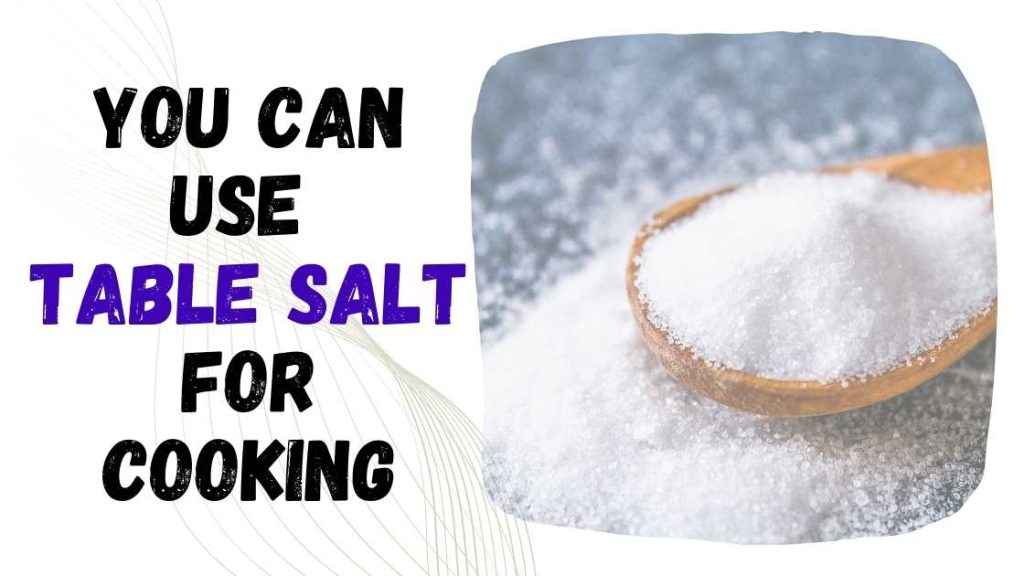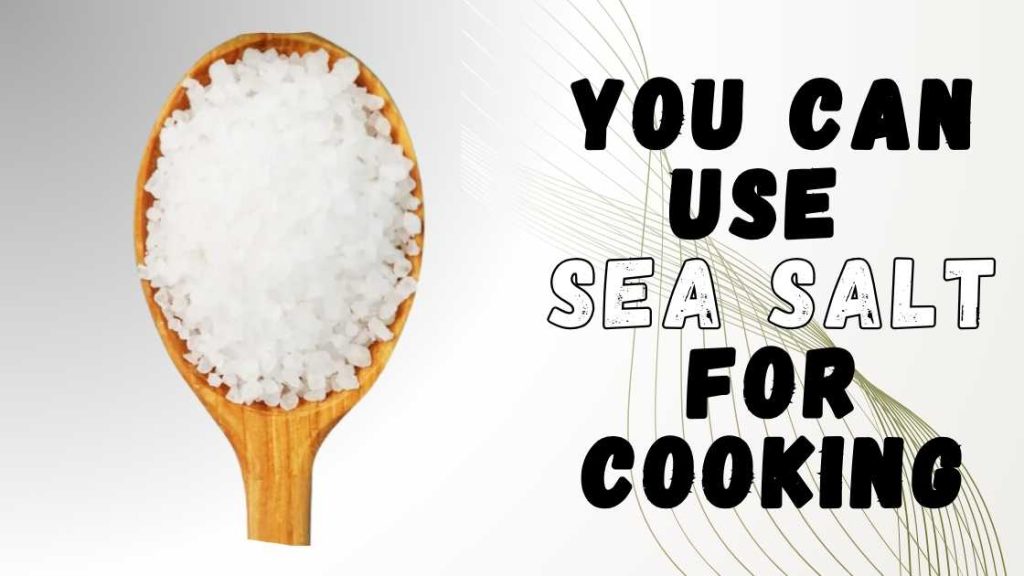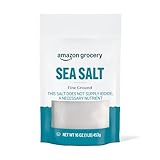Yes, you can use table salt for cooking. It’s a versatile and widely available ingredient that’s suitable for most culinary applications.
In my experience, table salt works particularly well in baking, where precise salt content is critical. The even granule size ensures that the salt is evenly distributed throughout the dough or batter, leading to consistent results. Be cautious when using table salt because it is more concentrated than coarser salts. Use a small amount to season, as it is potent.

What is Table Salt?
| Characteristic | Table Salt |
|---|---|
| Sodium Content (per 1g) | Approximately 390-400 mg |
| Common Additives | Anti-caking agents (e.g., calcium silicate) |
| Texture | Fine granules |
| Flavor Intensity | High (due to smaller granules) |
| Typical Use | General cooking, baking, seasoning |
| Availability | Widely available, inexpensive |
| Shelf Life | Indefinite if kept dry and sealed |
Table salt is a common and widely used type of salt, primarily composed of sodium chloride (NaCl). Here’s a closer look at what table salt is:
Processing
- Refinement: Table salt is typically refined to remove impurities and trace minerals. This process results in a pure, fine-grained product that dissolves easily in food.
- Additives: During processing, anti-caking agents are often added to table salt to prevent clumping, ensuring it remains free-flowing. Additionally, many brands fortify table salt with iodine, an essential nutrient that helps prevent iodine deficiency.
Table Salt vs. Sea Salt vs. Kosher Salt
| Type | Processing | Grain Size | Flavor | Usage |
|---|---|---|---|---|
| Table Salt | Refined, removing impurities and minerals | Finely ground | Straightforward, salty taste | General cooking, baking, seasoning |
| Sea Salt | Harvested from evaporated seawater | Varying sizes, from fine to coarse | Mild, subtle flavors influenced by minerals | Finishing dishes, enhancing flavors, rimming glassware |
| Kosher Salt | Traditional Jewish koshering process | Coarser crystals | Milder taste, less salty, allows better control | Koshering meat, general cooking, seasoning |
Grain Size
- Finely Ground: Table salt has a very fine grain size, which allows it to dissolve quickly and evenly in cooking and baking. Its fine texture makes it easy to measure precisely, which is particularly important in baking.
Flavor
- Straightforward, Salty Taste: Table salt has a clean, strong, and straightforward salty flavor. It’s highly concentrated, meaning a little goes a long way in seasoning food.
Usage
- General Cooking: Due to its fine texture and quick dissolving properties, table salt is ideal for general cooking. It’s commonly used in boiling water, seasoning soups, stews, and sauces, and for salting vegetables and pasta.
- Baking: Table salt’s fine grains make it perfect for baking, where precise measurements are crucial. It evenly distributes throughout batters and doughs, ensuring consistent seasoning.
- Seasoning: Because of its strong flavor, table salt is often used as a seasoning at the table or during food preparation.
Nutritional Aspects
- Iodized Salt: Many table salts are iodized, meaning they contain added iodine, which is important for thyroid health. Iodine was introduced to table salt in the early 20th century to combat iodine deficiency in the population.
- Sodium Content: Like all salts, table salt is high in sodium, which is an essential mineral but should be consumed in moderation to avoid health issues such as high blood pressure.
Why Table Salt is Suitable for Cooking
Table salt is a staple in most kitchens and has been used in cooking for centuries. It’s composed mainly of sodium chloride and usually includes anti-caking agents to prevent clumping. The fine grains dissolve easily in both hot and cold dishes, making it ideal for seasoning food evenly. Because of its refined nature, table salt has a consistent flavor, which is reliable when following recipes that require precise measurements.
While it may not offer the same flavor depth as sea salt or kosher salt, table salt is highly effective in bringing out the natural flavors of food. Its fine texture ensures that it blends smoothly with ingredients, whether you’re sprinkling it on vegetables, seasoning meat, or baking bread. However, because it’s more refined, table salt contains fewer trace minerals than less processed salts, which some people prefer for their health benefits or distinct flavors.
Use Table Salt for Cooking?
Table salt is a staple in most kitchens due to its versatility and ease of use. Here’s how to make the most of table salt in your cooking:
1. Seasoning
- General Cooking: Table salt is perfect for seasoning dishes during cooking. Its fine grains dissolve quickly, allowing for even distribution of flavor in soups, stews, sauces, and casseroles.
- Boiling Water: Add table salt to boiling water when cooking pasta, rice, potatoes, or vegetables. The salt enhances the flavor of the food as it cooks.
- Marinades and Rubs: Use table salt in marinades to help tenderize meat and infuse it with flavor. It can also be combined with herbs and spices to create dry rubs for meats, poultry, or fish.
2. Baking
- Precise Measurements: Table salt’s fine grain size makes it ideal for baking, where precise measurements are essential. It evenly seasons baked goods, enhancing flavors without altering the texture.
- Balancing Flavors: In baked goods, table salt balances sweetness and can enhance other flavors, such as chocolate or spices, making your desserts more flavorful.
3. Brining
- Brining Meat: Table salt is commonly used in brining solutions to enhance the flavor and juiciness of meats. For a basic brine, dissolve table salt in water, optionally with sugar and spices, and soak the meat for several hours before cooking.
- Quick Pickling: Use table salt to create a quick pickling brine for vegetables like cucumbers, carrots, or radishes. This method adds flavor and extends the shelf life of the vegetables.
4. Flavor Enhancer
- Finishing Dishes: While not typically used as a finishing salt due to its fine texture, table salt can still be sprinkled on dishes just before serving to enhance flavors, especially in hot dishes where it will dissolve quickly.
- Balancing Acidity: A small pinch of table salt can help balance the acidity in tomato-based dishes, such as sauces or soups, and enhance the overall flavor.
5. Preserving
- Curing: Table salt is often used in curing processes, such as for making homemade gravlax or preserved lemons, where its fine grains can penetrate and season the food effectively.
- Pickling: In traditional pickling, table salt is used to draw moisture out of vegetables and create a brine that helps preserve them while adding flavor.
6. Health and Safety
- Hand Cleaning: Table salt can also be used to scrub your hands after handling garlic, onions, or fish to remove odors.
- Extending Shelf Life: Adding a pinch of table salt to milk or cream can help extend its shelf life by slowing the growth of bacteria.
:max_bytes(150000):strip_icc()/20211201-salt-baked-fish-vicky-wasik-24-805cbe038a5445e397565617beba2266.jpg)
Credit: www.seriouseats.com
3 Tips for Using Table Salt
Here’s how to make the most of table salt with these practical tips:
1. Taste as You Go
- Why It Matters: Table salt is more concentrated than coarser salts like kosher or sea salt due to its fine grain size. This means it can easily lead to over-salting if you’re not careful.
- How to Apply: Start with a small amount of table salt and gradually add more as needed, tasting your food frequently throughout the cooking process. This approach helps you achieve the perfect level of seasoning without accidentally overwhelming the dish.
2. Substituting for Other Salts
- Why It Matters: Different salts have varying densities and salinity levels. Table salt is denser and more potent than kosher or sea salt, so using it in the same quantity as coarser salts can result in a dish that’s too salty.
- How to Apply: When substituting table salt for kosher or sea salt, reduce the amount by about half. For example, if a recipe calls for 1 teaspoon of kosher salt, use only about 1/2 teaspoon of table salt. This adjustment helps maintain the intended flavor balance in your dish.

Credit: www.amazon.com
6 Tips for Cooking with Table Salt
Cooking with table salt can be straightforward, but a few tips can help you use it more effectively and avoid common pitfalls:
1. Use Proper Measurements
- Precision: Table salt’s fine grains make it easy to measure precisely. Use measuring spoons for accuracy, especially in baking where precise amounts are crucial.
- Adjusting Quantities: If substituting table salt for other types of salt (like kosher or sea salt), remember to use about half the amount called for, as table salt is more concentrated.
2. Dissolve Well
- Even Distribution: Table salt dissolves quickly due to its fine texture, so it’s ideal for recipes where the salt needs to blend smoothly into the mixture, such as in soups, sauces, and batters.
- Avoid Over-Salting: Since it dissolves easily, start with a small amount and taste as you go to prevent over-salting your dish.
3. Add Gradually
- Layering Flavor: Add table salt in stages throughout the cooking process rather than all at once. This allows you to build flavor gradually and adjust to taste.
- Taste Regularly: Taste your dish frequently, especially when adding salt at different stages, to ensure the flavor is balanced.
4. Use for Baking
- Even Integration: Table salt is great for baking because its fine grains mix thoroughly with other ingredients. Ensure it’s well incorporated into dry ingredients before adding liquids.
- Flavor Balance: In baked goods, table salt helps to enhance sweetness and other flavors. Be precise with measurements to maintain the desired flavor profile.
5. Brining and Preserving
- Effective Brining: Table salt is effective in brining solutions for meats and vegetables. It dissolves completely in water, making it ideal for creating uniform brine solutions.
- Pickling: Use table salt for quick pickling solutions where fine salt helps to evenly distribute and dissolve in the liquid.
6. Avoid Overuse
- Health Considerations: Because table salt is highly concentrated, it’s easy to overuse. Be mindful of your salt intake for health reasons, and use salt sparingly, especially in dishes that will be consumed in large quantities.
7. Enhance Flavor
- Balancing Sweetness: A pinch of table salt can enhance the sweetness in desserts and baked goods, balancing the flavors and making them more complex.
- Seasoning Post-Cooking: While table salt is less commonly used as a finishing salt, it can still be used to season dishes just before serving, especially if you prefer a finer texture.
How is Table Salt Different from Sea Salt?
Table salt and sea salt are both forms of sodium chloride, but they differ in their sources and processing methods. Table salt is mined from underground salt deposits and heavily processed to achieve a fine texture. Sea salt is produced through the evaporation of seawater, which often leaves behind trace minerals and gives it a coarser texture. Sea salt has a slightly different flavor profile due to these minerals, while table salt has a more uniform taste.
Can I Use Table Salt in Baking?
Yes, table salt can be used in baking. It dissolves easily, which helps ensure even distribution throughout the dough or batter. However, since table salt is finer and more concentrated than some other salts, it’s important to use the correct amount specified in the recipe. If a recipe calls for coarse salt, you may need to adjust the quantity when using table salt to avoid over-salting.
Is Table Salt Safe for Daily Use?
Table salt is safe for daily use when consumed in moderation. It is a key source of sodium, an essential nutrient that helps regulate blood pressure and fluid balance in the body. However, excessive consumption of table salt can lead to health issues like high blood pressure and heart disease. The World Health Organization recommends limiting salt intake to less than 5 grams (about a teaspoon) per day.
Does Table Salt Expire?
Table salt does not expire in the traditional sense, as it is a mineral and does not spoil. However, over time, it may absorb moisture from the air, leading to clumping or changes in texture. Storing table salt in a cool, dry place in an airtight container can help maintain its quality.
Can Iodized Table Salt Be Used for All Cooking Purposes?
Yes, iodized table salt can be used for most cooking purposes. The iodine added to table salt does not significantly alter its flavor, making it suitable for seasoning, baking, and other culinary uses. However, some chefs prefer non-iodized salt for pickling or fermenting, as iodine can sometimes interfere with the fermentation process.
How Much Table Salt Should I Use in Cooking?
The amount of table salt to use in cooking depends on the dish and personal preference. A general guideline is to use about 1/4 to 1/2 teaspoon of salt per cup of liquid in soups or sauces. For seasoning meat or vegetables, start with a small amount and adjust to taste. It’s easier to add more salt if needed, but difficult to correct over-salting.
Is Table Salt the Same as Kosher Salt?
No, table salt and kosher salt are not the same. Kosher salt has larger, coarser grains and is less dense than table salt. Because of its texture, kosher salt is often used for seasoning meat and in recipes where a crunchy texture is desired. When substituting kosher salt for table salt, you may need to use a larger quantity to achieve the same level of saltiness.
How Can I Prevent Table Salt from Clumping?
To prevent table salt from clumping, store it in a cool, dry place away from moisture. You can also add a few grains of uncooked rice to the salt shaker, as rice absorbs excess moisture and helps keep the salt free-flowing.
Why Is Table Salt Iodized?
Table salt is iodized to prevent iodine deficiency, which can lead to thyroid problems and other health issues. Iodine is an essential nutrient, and adding it to salt is an effective way to ensure that people receive enough iodine in their diet, especially in areas where iodine-rich foods are not commonly consumed.
Final Thought
Table salt is perfectly suitable for cooking and is the most commonly used salt in culinary applications. Its fine texture, even dissolving, and widespread availability make it a convenient choice for seasoning and baking. However, if you’re aiming for specific flavors or following a low-iodine diet, you may want to consider other types of salt such as sea salt or kosher salt.

I may be a little “crazy” when it comes to cooking, but I enjoy every minute of it. Spending time in the kitchen itself, whether with my family or my friends, brings me both happiness and exhilaration. This blog was created to showcase my cooking/eating with family and friends. And also as an opportunity to discuss ideas on food and the culinary circle in general.




